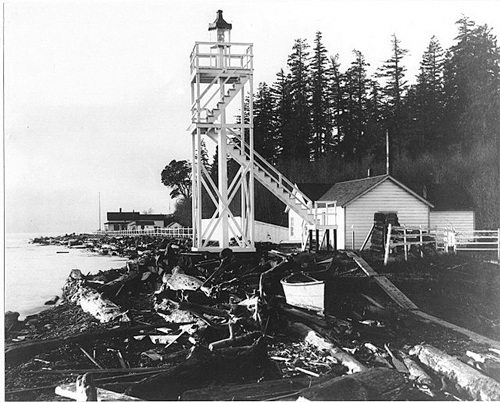Point Robinson marks the halfway point between Seattle and Tacoma and is the most eastward point in the main shipping channel of Puget Sound. It was named in 1841 by the Charles Wilkes Expedition in honor of Quartermaster John Robinson. Early sailors labeled this area a “fog net,” because fog often obscured the point, creating a navigation hazard.
In 1884, the U.S. Lighthouse Service purchased 24 acres at the point to build a fog signal. At this time the point was very similar to what KVI Beach is today, a long sand spit stabilized by drift logs surrounding a salt mash.
Construction of the fog signal began in June 1884 when the S. S. Shubrick, a 140-foot side-wheeler lighthouse tender, delivered building materials and the fog signal machinery. The construction was completed in May 1885, and the facility was dedicated on July 1, 1885. Franklin Tucker was the first station keeper and was housed in the first of the two light keepers quarters, which was built in that year.
In 1887, a kerosene fixed red light on a 25-foot pole was added until a more permanent structure could be built. Sailors approaching the light from the south complained that the red light was partially obscured by the keeper’s quarters, so in 1894 an open tower was built. To stabilize the beach and mudflats, a log bulkhead was built that cut the marsh in half, beginning the process of it being filled in.
After the fog signal was used continuously for 528 hours in 1897 — and the keeper shoveled more than 35 tons of coal to keep the signal going — a second keeper was added in 1903. The second keeper’s quarters were built four years later.
Increased vessel traffic led to the Lighthouse Service receiving funds to expand the number of lighthouses on the Sound, and in 1915 the current lighthouse was constructed. The 38-foot tower was equipped with a fifth-order Fresnel lens manufactured in Paris by L. Sautter, Lemmonier, giving the light a 12-mile range; the steam fog signal was replaced with a compressed air signal. By 1917 the salt marsh completely disappeared from drawings of Point Robinson, and a road was constructed up the hillside to connect the point with the rest of Maury Island.
The Lighthouse Service was disbanded in 1939, and the U.S. Coast Guard took responsibility for the lighthouse. Jens Olaf Pedersen, a civilian keeper who served at Point Robinson from 1936 to 1954, was allowed to continue as a keeper until his retirement. His son Jens, who grew up at the lighthouse, still lives on Vashon. The fog signal was updated in 1946, and in 1959 the U.S. government surplussed 12 acres of the site. When the parcel did not sell, the acreage was transferred to King County as a park.
In 1978, the Coast Guard automated the lighthouse, and the last Coast Guardsman, Jerry Bolstad, was stationed there in 1989. That same year, a 100-foot radar tower was built at the point as part of the Puget Sound Vessel Traffic Control System that functions to control ship traffic on Puget Sound. In the early 1990s, two GPS WASS towers were constructed to give ships in the area an accurate GPS reading.
In 1995 King County transferred operation of Point Robinson to the Vashon Park District. In the late 1990s, Islanders became concerned about the possibility of Point Robinson being leased for a commercial operation, so the Friends of Point Robinson was formed. The Friends, under the leadership of Capt. Joe Wubbold, worked with the park district to negotiate a 15-year lease for the site and develop a plan to restore it for public use; they also changed their name to The Keepers of Point Robinson.
The park district obtained a free long-term lease of the property in 1997, and in 2003, the first of the two keeper’s quarters was opened to the public as a rental. The second keeper’s quarters was opened in 2008.
That same year, a replaceable beacon was added to be used in the lighthouse tower, but the Keepers convinced the Coast Guard to leave the original Fresnel lens in place in the lamp room.
Today you can tour the lighthouse, attend the annual Kite Day Festival, celebrate the mid-summer Low Tide Festival, rent one of the keeper’s quarters for a week or linger on the beach to watch Mount Rainier, passing ships and the resident orca pods as they transit the point.
— Bruce Haulman is an Island historian. Terry Donnelly is a nationally recognized landscape photographer.



